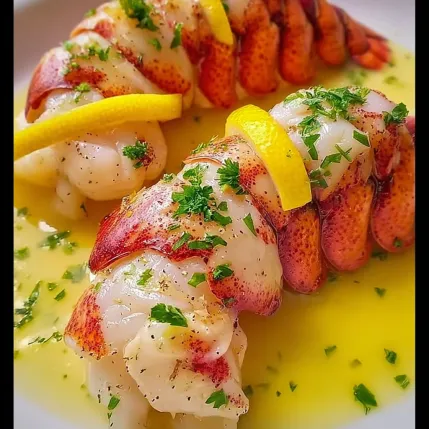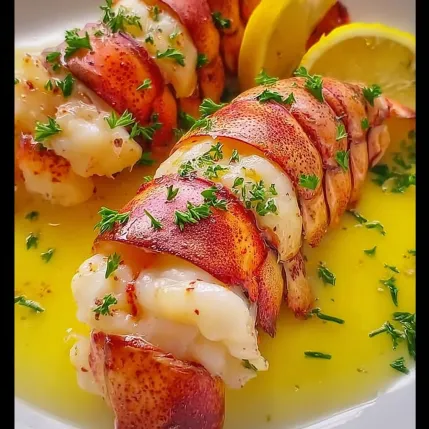 Save
Save
This butter poached lobster is the kind of dish you make when you want to create a little magic at home. The lobster is poached low and slow in a garlic truffle butter that turns every bite into something truly memorable. Tossed with linguine or served with crusty bread it is elegant without being fussy and always earns praise.
I made this for our anniversary one year and it became our tradition every June since then. Even the leftovers taste special.
Ingredients
- Lobster tails: offer sweet rich flavor and poach beautifully when removed from the shell
- Water: helps start the emulsion when making the butter base
- Cultured butter: gives the sauce its rich nutty profile look for grass fed varieties like Kerrygold
- Garlic: adds aromatic depth use freshly chopped for best results
- Truffle salt: brings a subtle earthiness substitute fine sea salt if needed
- Red pepper flakes: lend gentle heat balance to the buttery richness
- Bay leaf: layers in savory herbal complexity remove before serving
- Lemon juice: brightens the sauce and cuts the richness use freshly squeezed
- Black pepper: provides sharp finishing balance grind fresh for best aroma
- Linguine: soaks up the buttery sauce choose bronze cut pasta for best texture
- Flat leaf parsley: adds freshness and color chop just before using for full flavor
Step-by-Step Instructions
- Prepare the Lobster:
- Use kitchen shears to cut down the soft underside of each shell from tip to base then gently work your thumb under the meat to release it in one whole piece. If you see a dark digestive vein slit it open and remove.
- Build the Butter Base:
- Place a 10 inch skillet over medium low heat and pour in the water. Let it heat slightly then whisk in one piece of butter until melted. Add a second piece and whisk again to create a creamy emulsion.
- Infuse the Aromatics:
- Add the chopped garlic truffle salt red pepper flakes and bay leaf to the skillet. Whisk continuously so the flavors incorporate evenly into the butter.
- Add the Rest of the Butter:
- Continue adding butter one piece at a time whisking slowly between additions. Keep the temperature between 160 and 189 degrees Fahrenheit with an ideal target of 180. Do not let it bubble or brown.
- Poach the Lobster:
- Place the lobster tails in the butter in a single snug layer. Turn them gently every minute or two and cook until just opaque all the way through about six minutes total. Remove from heat.
- Cook the Pasta:
- If using linguine cook it in a large pot of well salted water according to package directions until just al dente. Drain well and reserve.
- Finish the Dish:
- If serving with bread sprinkle lemon juice black pepper and chopped parsley directly into the pan. If serving with pasta remove the lobster and bay leaf then stir lemon juice black pepper and parsley into the butter. Toss with linguine and serve each portion topped with two lobster tails.
 Save
Save
I always look forward to the way the butter smells as it melts with garlic and truffle salt. It reminds me of quiet nights when everything else fades but dinner and conversation.
Storage Tips
Lobster leftovers store well in an airtight container in the fridge for up to four days. Reheat gently on the stove over low heat to preserve tenderness. Avoid the microwave as it may toughen the meat.
Ingredient Substitutions
If truffle salt is not available fine sea salt will work though you will miss the earthy nuance. For butter stick with cultured options when possible. Broccoli microgreens can take the place of parsley for a delicate garnish.
Serving Suggestions
For a lighter presentation serve lobster over steamed asparagus or sautéed spinach. Garlic rubbed toasted sourdough makes a great pairing if skipping pasta. Add a crisp white wine like sauvignon blanc to complement the butter sauce.
 Save
Save
Cultural Context
Poaching seafood in butter is a French technique known as beurre monté which keeps the butter from breaking. This version takes a luxe American twist with truffle and linguine making it a modern celebration dish.
Common Recipe Questions
- → What kind of lobster tails should I use?
Cold-water lobster tails are best for their sweet, firm texture and superior flavor. Avoid warm-water varieties when possible.
- → Why is butter poaching better than boiling?
Butter poaching keeps the lobster tender and moist, preserving delicate flavors and preventing overcooking common with boiling.
- → Can I use regular butter instead of cultured?
Yes, but cultured butter from grass-fed cows adds a richer, tangier flavor that enhances the overall dish.
- → Do I need truffle salt?
Truffle salt adds depth but can be replaced with fine sea salt for a simpler, still delicious version.
- → Can I make this dish ahead of time?
It's best enjoyed fresh, but leftovers can be stored in an airtight container for up to four days and reheated gently.
- → What can I serve this with?
This dish pairs beautifully with linguine, crusty bread, or light sides like a green salad or roasted vegetables.
